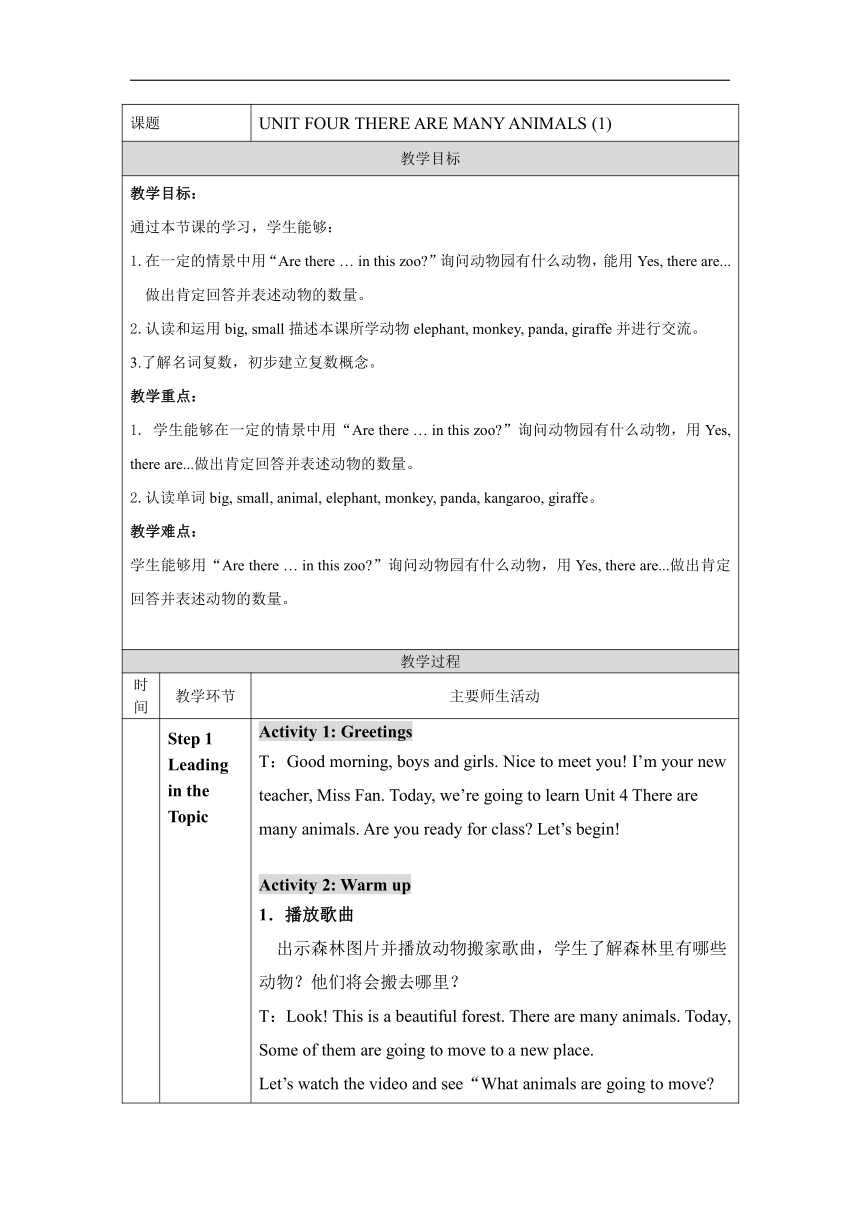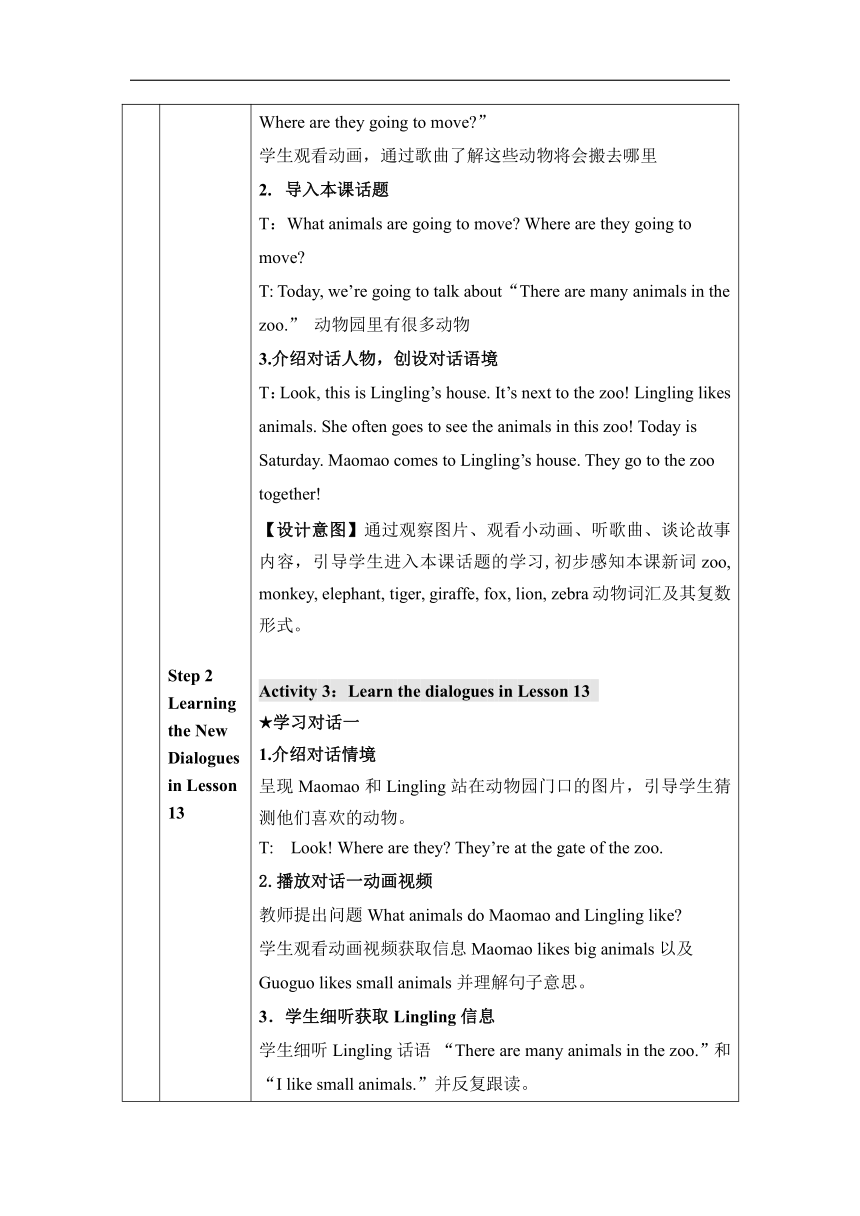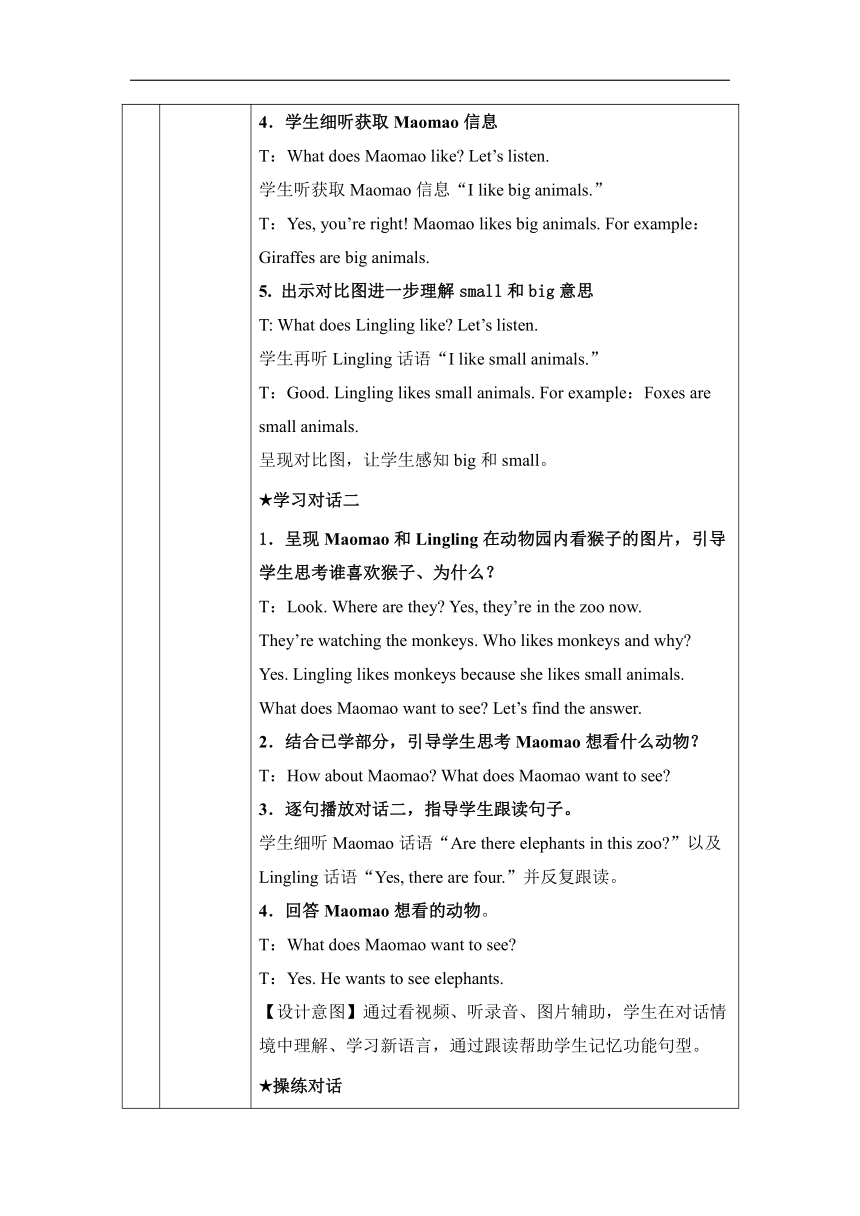Unit 4 There are many animals Lesson13 教案
文档属性
| 名称 | Unit 4 There are many animals Lesson13 教案 |  | |
| 格式 | docx | ||
| 文件大小 | 37.7KB | ||
| 资源类型 | 教案 | ||
| 版本资源 | 北京版 | ||
| 科目 | 英语 | ||
| 更新时间 | 2021-08-24 23:21:27 | ||
图片预览



文档简介
课题
UNIT
FOUR
THERE
ARE
MANY
ANIMALS
(1)
教学目标
教学目标:
通过本节课的学习,学生能够:
1.在一定的情景中用“Are
there
…
in
this
zoo?”询问动物园有什么动物,能用Yes,
there
are...做出肯定回答并表述动物的数量。
2.认读和运用big,
small描述本课所学动物elephant,
monkey,
panda,
giraffe并进行交流。
3.了解名词复数,初步建立复数概念。
教学重点:
1.
学生能够在一定的情景中用“Are
there
…
in
this
zoo?”询问动物园有什么动物,用Yes,
there
are...做出肯定回答并表述动物的数量。
2.认读单词big,
small,
animal,
elephant,
monkey,
panda,
kangaroo,
giraffe。
教学难点:
学生能够用“Are
there
…
in
this
zoo?”询问动物园有什么动物,用Yes,
there
are...做出肯定回答并表述动物的数量。
教学过程
时间
教学环节
主要师生活动
Step
1
Leading
in
the
Topic
Step
2
Learning
the
New
Dialogues
in
Lesson
13
Step
3
Practice
to
use
the
Dialogu
e
Step
4
Phonics
Time
Step
5
Summary
Activity
1:
Greetings
T:Good
morning,
boys
and
girls.
Nice
to
meet
you!
I’m
your
new
teacher,
Miss
Fan.
Today,
we’re
going
to
learn
Unit
4
There
are
many
animals.
Are
you
ready
for
class?
Let’s
begin!
Activity
2:
Warm
up
1.播放歌曲
出示森林图片并播放动物搬家歌曲,学生了解森林里有哪些动物?他们将会搬去哪里?
T:Look!
This
is
a
beautiful
forest.
There
are
many
animals.
Today,
Some
of
them
are
going
to
move
to
a
new
place.
Let’s
watch
the
video
and
see“What
animals
are
going
to
move?
Where
are
they
going
to
move?”
学生观看动画,通过歌曲了解这些动物将会搬去哪里
导入本课话题
T:What
animals
are
going
to
move?
Where
are
they
going
to
move?
T:
Today,
we’re
going
to
talk
about“There
are
many
animals
in
the
zoo.”
动物园里有很多动物
3.介绍对话人物,创设对话语境
T:Look,
this
is
Lingling’s
house.
It’s
next
to
the
zoo!
Lingling
likes
animals.
She
often
goes
to
see
the
animals
in
this
zoo!
Today
is
Saturday.
Maomao
comes
to
Lingling’s
house.
They
go
to
the
zoo
together!
【设计意图】通过观察图片、观看小动画、听歌曲、谈论故事内容,引导学生进入本课话题的学习,初步感知本课新词zoo,
monkey,
elephant,
tiger,
giraffe,
fox,
lion,
zebra动物词汇及其复数形式。
Activity
3:Learn
the
dialogues
in
Lesson
13
★学习对话一
1.介绍对话情境
呈现Maomao和Lingling站在动物园门口的图片,引导学生猜测他们喜欢的动物。
T:
Look!
Where
are
they?
They’re
at
the
gate
of
the
zoo.
2.播放对话一动画视频
教师提出问题What
animals
do
Maomao
and
Lingling
like?
学生观看动画视频获取信息Maomao
likes
big
animals以及Guoguo
likes
small
animals并理解句子意思。
3.学生细听获取Lingling信息
学生细听Lingling话语
“There
are
many
animals
in
the
zoo.”和
“I
like
small
animals.”并反复跟读。
4.学生细听获取Maomao信息
T:What
does
Maomao
like?
Let’s
listen.
学生听获取Maomao信息“I
like
big
animals.”
T:Yes,
you’re
right!
Maomao
likes
big
animals.
For
example:Giraffes
are
big
animals.
5.
出示对比图进一步理解small和big意思
T:
What
does
Lingling
like?
Let’s
listen.
学生再听Lingling话语“I
like
small
animals.”
T:Good.
Lingling
likes
small
animals.
For
example:Foxes
are
small
animals.
呈现对比图,让学生感知big和small。
★学习对话二
1.呈现Maomao和Lingling在动物园内看猴子的图片,引导学生思考谁喜欢猴子、为什么?
T:Look.
Where
are
they?
Yes,
they’re
in
the
zoo
now.
They’re
watching
the
monkeys.
Who
likes
monkeys
and
why?
Yes.
Lingling
likes
monkeys
because
she
likes
small
animals.
What
does
Maomao
want
to
see?
Let’s
find
the
answer.
2.结合已学部分,引导学生思考Maomao想看什么动物?
T:How
about
Maomao?
What
does
Maomao
want
to
see?
3.逐句播放对话二,指导学生跟读句子。
学生细听Maomao话语“Are
there
elephants
in
this
zoo?”以及Lingling话语“Yes,
there
are
four.”并反复跟读。
4.回答Maomao想看的动物。
T:What
does
Maomao
want
to
see?
T:Yes.
He
wants
to
see
elephants.
【设计意图】通过看视频、听录音、图片辅助,学生在对话情境中理解、学习新语言,通过跟读帮助学生记忆功能句型。
★操练对话
1.播放完整对话音频,指导学生跟读。
T:Now
let’s
listen
and
read
the
dialogues.
2.师生分角色交替扮演对话,再次操练句型。
3.小黑板小结本课功能句型
【设计意图】在跟读录音过程中,引导学生练习句型,读准发音;通过分角色朗读,帮助学生记忆功能句型;通过小黑板总结本课功能句型,帮助学生做阶段性小结。
Activity
4:
Practice
the
language
1.呈现Maomao回家与妈妈对话图,操练功能句。
T:Look!
This
is
Maomao’s
home,
and
the
woman
is
Maomao’s
mum,
she
is
waiting
for
Maomao.
2.老师领读,引导学生跟读对话内容。
T:Now,
please
read
after
me.
学生跟随教师逐句跟读。
【设计意图】在新的场景中拓展本课对话,指导学生在不同的场景中运用本课功能句型,并学习新的词汇。
Activity
5:
Use
the
language
呈现三个外国小朋友Sara,
Peter,
Mingming跟随导游参观北京动物园的场景,检查学生是否掌握并灵活运用本课主要功能句型。
场景一:呈现导游和小朋友在动物园外场景
T:Children.
Follow
me
please.
Let’s
go.
场景二:呈现导游和小朋友在动物园内参观场景
1.考察学生会提问“Are
there
…
in
the
zoo?”
呈现三个小朋友站在草坪上,远处是狮子和老虎园区,导游在为他们介绍。
T:There
are
two
lions
and
a
tiger.
小女孩Sara回答“I
like
big
animals.
…?”
T:
Look.
There
is
a
toy
giraffe
in
her
hand.
Please
think
about
what
she
will
ask.
Sara手上的长颈鹿玩具放大呈现,引导学生思考Sara该如何询问导游。
T:
Good
job.
呈现对话“I
like
big
animals.
Are
there
giraffes
in
the
zoo?”
2.考察学生会回答
“Yes,
there
are
…
.”
导游头上呈现云图,有三头长颈鹿,让学生思考该如何回答。
T:How
many
giraffes
are
there
in
the
zoo?
So
the
tour
guide
will
say
“Yes,
there
are
three.”
3.老师领读,引导学生跟读。
T:Now,
please
read
after
me.
学生根据手指手势逐句跟读。
T:
Peter
wears
a
cap
with
a
panda.
Please
think
about
what
he
will
ask.
Peter头上的熊猫帽子放大呈现,引导学生思考Peter该如何询问导游。
T:
Super!
呈现对话“Are
there
pandas
in
the
zoo?”
4.考察学生会回答
“Yes,
there
are
…
.”
导游头上呈现云图,有四头熊猫,让学生思考该如何回答。
T:What
will
Lily
say?
Lily
will
say
“Yes,
there
are
four.”
5.老师领读,引导学生跟读。
T:Now,
please
read
after
me.
学生根据手指手势逐句跟读。
T:
Please
think
about
what
he
will
ask.
把Mingming斑马气球放大呈现,引导学生思考Minging该如何询问导游。呈现对话“Are
there
zebras
in
the
zoo?”
6.考察学生会回答
“Yes,
there
are
…
.”
导游头上呈现云图,有六匹斑马,让学生思考该如何回答。
T:Lily
will
say
“Yes,
there
are
six.”
7.老师领读,引导学生跟读。
T:Now,
please
read
after
me.
学生根据手指手势逐句跟读。
【设计意图】通过创设三个小朋友跟随导游参观北京动物园的故事情境,考察学生是否掌握本课功能句型。
Activity
6:
Phonics
Time
1.出示标题
Phonics
Time
T:
It’s
our
phonics
time.
First,
I
will
tell
you
a
story.
播放自制故事绘本
An
Old
Mole
I’m
an
old
mole.
My
name
is
CEO.
I
have
a
big
nose.
I
want
a
home.
I
go
to
find
a
hole.
It
looks
like
a
UFO.
Oh!
No!
The
old
mole
is
flying
with
the
UFO.
I
don’t
want
to
go!
教师结合课件讲故事,然后回顾呈现故事中含有字母Oo的单词,分为两类old
mole,nose,
home,
hole以及CEO,
UFO,
no,
go引导学生感知字母Oo在这些单词中的发音。
2.学习拼读含有字母Oo的单词
课件呈现单词no,
go,
nose,
rose及相应的图片,并通过课件变化首尾字母,指导学生拼读这些单词,分类感悟字母Oo在绝对开音节(以o为结尾)和相对开音节(以不发音的e结尾)中的发音。
【设计意图】将含有字母Oo的开音节单词呈现在一起,引导学生借助已知单词的发音,感知元音字母Oo在开音节中的发音并根据发音规则尝试拼读新单词。
Activity
7:
Summarize
the
language
and
the
pronunciation
of
letter
“Oo”
呈现小黑板,逐一归纳本课主要功能句型和语音单词。
Activity8:
Homework
1.
listen
and
read
lesson
13.
2.
判断下列句子与图片是否相符。
【设计意图】总结梳理对话、语音部分。布置作业。
UNIT
FOUR
THERE
ARE
MANY
ANIMALS
(1)
教学目标
教学目标:
通过本节课的学习,学生能够:
1.在一定的情景中用“Are
there
…
in
this
zoo?”询问动物园有什么动物,能用Yes,
there
are...做出肯定回答并表述动物的数量。
2.认读和运用big,
small描述本课所学动物elephant,
monkey,
panda,
giraffe并进行交流。
3.了解名词复数,初步建立复数概念。
教学重点:
1.
学生能够在一定的情景中用“Are
there
…
in
this
zoo?”询问动物园有什么动物,用Yes,
there
are...做出肯定回答并表述动物的数量。
2.认读单词big,
small,
animal,
elephant,
monkey,
panda,
kangaroo,
giraffe。
教学难点:
学生能够用“Are
there
…
in
this
zoo?”询问动物园有什么动物,用Yes,
there
are...做出肯定回答并表述动物的数量。
教学过程
时间
教学环节
主要师生活动
Step
1
Leading
in
the
Topic
Step
2
Learning
the
New
Dialogues
in
Lesson
13
Step
3
Practice
to
use
the
Dialogu
e
Step
4
Phonics
Time
Step
5
Summary
Activity
1:
Greetings
T:Good
morning,
boys
and
girls.
Nice
to
meet
you!
I’m
your
new
teacher,
Miss
Fan.
Today,
we’re
going
to
learn
Unit
4
There
are
many
animals.
Are
you
ready
for
class?
Let’s
begin!
Activity
2:
Warm
up
1.播放歌曲
出示森林图片并播放动物搬家歌曲,学生了解森林里有哪些动物?他们将会搬去哪里?
T:Look!
This
is
a
beautiful
forest.
There
are
many
animals.
Today,
Some
of
them
are
going
to
move
to
a
new
place.
Let’s
watch
the
video
and
see“What
animals
are
going
to
move?
Where
are
they
going
to
move?”
学生观看动画,通过歌曲了解这些动物将会搬去哪里
导入本课话题
T:What
animals
are
going
to
move?
Where
are
they
going
to
move?
T:
Today,
we’re
going
to
talk
about“There
are
many
animals
in
the
zoo.”
动物园里有很多动物
3.介绍对话人物,创设对话语境
T:Look,
this
is
Lingling’s
house.
It’s
next
to
the
zoo!
Lingling
likes
animals.
She
often
goes
to
see
the
animals
in
this
zoo!
Today
is
Saturday.
Maomao
comes
to
Lingling’s
house.
They
go
to
the
zoo
together!
【设计意图】通过观察图片、观看小动画、听歌曲、谈论故事内容,引导学生进入本课话题的学习,初步感知本课新词zoo,
monkey,
elephant,
tiger,
giraffe,
fox,
lion,
zebra动物词汇及其复数形式。
Activity
3:Learn
the
dialogues
in
Lesson
13
★学习对话一
1.介绍对话情境
呈现Maomao和Lingling站在动物园门口的图片,引导学生猜测他们喜欢的动物。
T:
Look!
Where
are
they?
They’re
at
the
gate
of
the
zoo.
2.播放对话一动画视频
教师提出问题What
animals
do
Maomao
and
Lingling
like?
学生观看动画视频获取信息Maomao
likes
big
animals以及Guoguo
likes
small
animals并理解句子意思。
3.学生细听获取Lingling信息
学生细听Lingling话语
“There
are
many
animals
in
the
zoo.”和
“I
like
small
animals.”并反复跟读。
4.学生细听获取Maomao信息
T:What
does
Maomao
like?
Let’s
listen.
学生听获取Maomao信息“I
like
big
animals.”
T:Yes,
you’re
right!
Maomao
likes
big
animals.
For
example:Giraffes
are
big
animals.
5.
出示对比图进一步理解small和big意思
T:
What
does
Lingling
like?
Let’s
listen.
学生再听Lingling话语“I
like
small
animals.”
T:Good.
Lingling
likes
small
animals.
For
example:Foxes
are
small
animals.
呈现对比图,让学生感知big和small。
★学习对话二
1.呈现Maomao和Lingling在动物园内看猴子的图片,引导学生思考谁喜欢猴子、为什么?
T:Look.
Where
are
they?
Yes,
they’re
in
the
zoo
now.
They’re
watching
the
monkeys.
Who
likes
monkeys
and
why?
Yes.
Lingling
likes
monkeys
because
she
likes
small
animals.
What
does
Maomao
want
to
see?
Let’s
find
the
answer.
2.结合已学部分,引导学生思考Maomao想看什么动物?
T:How
about
Maomao?
What
does
Maomao
want
to
see?
3.逐句播放对话二,指导学生跟读句子。
学生细听Maomao话语“Are
there
elephants
in
this
zoo?”以及Lingling话语“Yes,
there
are
four.”并反复跟读。
4.回答Maomao想看的动物。
T:What
does
Maomao
want
to
see?
T:Yes.
He
wants
to
see
elephants.
【设计意图】通过看视频、听录音、图片辅助,学生在对话情境中理解、学习新语言,通过跟读帮助学生记忆功能句型。
★操练对话
1.播放完整对话音频,指导学生跟读。
T:Now
let’s
listen
and
read
the
dialogues.
2.师生分角色交替扮演对话,再次操练句型。
3.小黑板小结本课功能句型
【设计意图】在跟读录音过程中,引导学生练习句型,读准发音;通过分角色朗读,帮助学生记忆功能句型;通过小黑板总结本课功能句型,帮助学生做阶段性小结。
Activity
4:
Practice
the
language
1.呈现Maomao回家与妈妈对话图,操练功能句。
T:Look!
This
is
Maomao’s
home,
and
the
woman
is
Maomao’s
mum,
she
is
waiting
for
Maomao.
2.老师领读,引导学生跟读对话内容。
T:Now,
please
read
after
me.
学生跟随教师逐句跟读。
【设计意图】在新的场景中拓展本课对话,指导学生在不同的场景中运用本课功能句型,并学习新的词汇。
Activity
5:
Use
the
language
呈现三个外国小朋友Sara,
Peter,
Mingming跟随导游参观北京动物园的场景,检查学生是否掌握并灵活运用本课主要功能句型。
场景一:呈现导游和小朋友在动物园外场景
T:Children.
Follow
me
please.
Let’s
go.
场景二:呈现导游和小朋友在动物园内参观场景
1.考察学生会提问“Are
there
…
in
the
zoo?”
呈现三个小朋友站在草坪上,远处是狮子和老虎园区,导游在为他们介绍。
T:There
are
two
lions
and
a
tiger.
小女孩Sara回答“I
like
big
animals.
…?”
T:
Look.
There
is
a
toy
giraffe
in
her
hand.
Please
think
about
what
she
will
ask.
Sara手上的长颈鹿玩具放大呈现,引导学生思考Sara该如何询问导游。
T:
Good
job.
呈现对话“I
like
big
animals.
Are
there
giraffes
in
the
zoo?”
2.考察学生会回答
“Yes,
there
are
…
.”
导游头上呈现云图,有三头长颈鹿,让学生思考该如何回答。
T:How
many
giraffes
are
there
in
the
zoo?
So
the
tour
guide
will
say
“Yes,
there
are
three.”
3.老师领读,引导学生跟读。
T:Now,
please
read
after
me.
学生根据手指手势逐句跟读。
T:
Peter
wears
a
cap
with
a
panda.
Please
think
about
what
he
will
ask.
Peter头上的熊猫帽子放大呈现,引导学生思考Peter该如何询问导游。
T:
Super!
呈现对话“Are
there
pandas
in
the
zoo?”
4.考察学生会回答
“Yes,
there
are
…
.”
导游头上呈现云图,有四头熊猫,让学生思考该如何回答。
T:What
will
Lily
say?
Lily
will
say
“Yes,
there
are
four.”
5.老师领读,引导学生跟读。
T:Now,
please
read
after
me.
学生根据手指手势逐句跟读。
T:
Please
think
about
what
he
will
ask.
把Mingming斑马气球放大呈现,引导学生思考Minging该如何询问导游。呈现对话“Are
there
zebras
in
the
zoo?”
6.考察学生会回答
“Yes,
there
are
…
.”
导游头上呈现云图,有六匹斑马,让学生思考该如何回答。
T:Lily
will
say
“Yes,
there
are
six.”
7.老师领读,引导学生跟读。
T:Now,
please
read
after
me.
学生根据手指手势逐句跟读。
【设计意图】通过创设三个小朋友跟随导游参观北京动物园的故事情境,考察学生是否掌握本课功能句型。
Activity
6:
Phonics
Time
1.出示标题
Phonics
Time
T:
It’s
our
phonics
time.
First,
I
will
tell
you
a
story.
播放自制故事绘本
An
Old
Mole
I’m
an
old
mole.
My
name
is
CEO.
I
have
a
big
nose.
I
want
a
home.
I
go
to
find
a
hole.
It
looks
like
a
UFO.
Oh!
No!
The
old
mole
is
flying
with
the
UFO.
I
don’t
want
to
go!
教师结合课件讲故事,然后回顾呈现故事中含有字母Oo的单词,分为两类old
mole,nose,
home,
hole以及CEO,
UFO,
no,
go引导学生感知字母Oo在这些单词中的发音。
2.学习拼读含有字母Oo的单词
课件呈现单词no,
go,
nose,
rose及相应的图片,并通过课件变化首尾字母,指导学生拼读这些单词,分类感悟字母Oo在绝对开音节(以o为结尾)和相对开音节(以不发音的e结尾)中的发音。
【设计意图】将含有字母Oo的开音节单词呈现在一起,引导学生借助已知单词的发音,感知元音字母Oo在开音节中的发音并根据发音规则尝试拼读新单词。
Activity
7:
Summarize
the
language
and
the
pronunciation
of
letter
“Oo”
呈现小黑板,逐一归纳本课主要功能句型和语音单词。
Activity8:
Homework
1.
listen
and
read
lesson
13.
2.
判断下列句子与图片是否相符。
【设计意图】总结梳理对话、语音部分。布置作业。
同课章节目录
- Unit 1 What day is today?
- Lesson 1
- Lesson 2
- Lesson 3
- Lesson 4
- Unit 2 What do you do on Sunday?
- Lesson 5
- Lesson 6
- Lesson 7
- Lesson 8
- Unit 3 What's your number?
- Lesson 9
- Lesson 10
- Lesson 11
- Lesson 12
- Unit 4 There are many animals
- Lesson 13
- Lesson 14
- Lesson 15
- Lesson 16
- Unit 5 I have long arms
- Lesson 17
- Lesson 18
- Lesson 19
- Lesson 20
- Unit 6 It‘s Christmas Day
- Lesson 21
- Lesson 22
- Lesson 23
- Lesson 24
